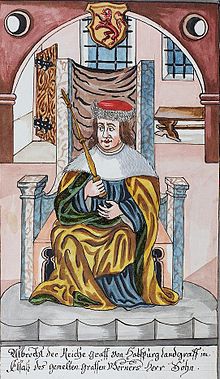
The House of Habsburg, also known as the House of Austria, was one of the most prominent and important dynasties in European history.

Albert I of Habsburg was a Duke of Austria and Styria from 1282 and King of Germany from 1298 until his assassination. He was the eldest son of King Rudolf I of Germany and his first wife Gertrude of Hohenberg. Sometimes referred to as 'Albert the One-eyed' because of a battle injury that left him with a hollow eye socket and a permanent snarl.

Rudolf I was the first King of Germany of the Habsburg dynasty from 1273 until his death.
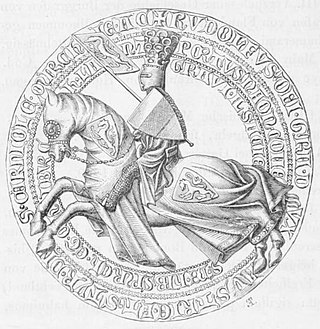
Rudolf I, also known as Rudolf of Habsburg, was a member of the House of Habsburg, the King of Bohemia and titular King of Poland from 1306 until his death. He was also Duke of Austria and Styria from 1298.

Rudolph, called the Valiant, was the Duke of Lorraine from 1328 to his death. He was the son and successor of Frederick IV, Duke of Lorraine and Elisabeth of Austria, the daughter of King Albert I of Germany of the House of Habsburg. Though he was but nine years of age when his father died and he succeeded to the duchy under the regency of his mother, he was a warrior prince, taking part in four separate wars in Lorraine, France, Brittany, and Iberia. He was killed at the Battle of Crécy.
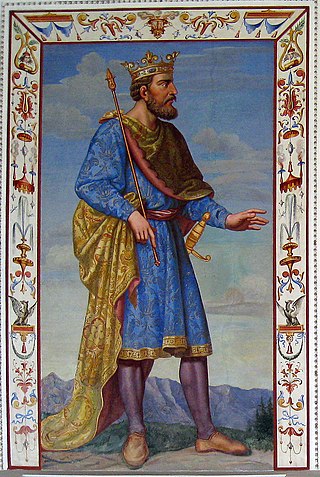
Henry of Gorizia, a member of the House of Gorizia, was Duke of Carinthia and Landgrave of Carniola and Count of Tyrol from 1295 until his death, as well as King of Bohemia, Margrave of Moravia and titular King of Poland in 1306 and again from 1307 until 1310. After his death, the Habsburgs took over Carinthia and Carniola and held them almost without interruption until 1918.
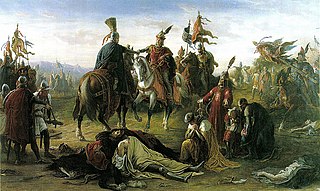
The Battle on the Marchfeld ; Polish: Bitwa pod Suchymi Krutami at Dürnkrut and Jedenspeigen took place on 26 August 1278 and was a decisive event for the history of Central Europe for the following centuries. The opponents were a Bohemian (Czech) army led by the Přemyslid king Ottokar II of Bohemia and the German army under the German king Rudolph I of Habsburg in alliance with King Ladislaus IV of Hungary. With 15,300 mounted troops, it was one of the largest cavalry battles in Central Europe during the Middle Ages. The Hungarian cavalry played a significant role in the outcome of the battle.

Rudolf II, a member of the House of Habsburg, was Duke of Austria and Styria from 1282 to 1283, jointly with his elder brother Albert I, who succeeded him.

Leopold I, called The Glorious, was Duke of Austria and Styria – as co-ruler with his elder brother Frederick the Fair – from 1308 until his death. A member of the House of Habsburg, he was the third son of Albert I of Germany and Elisabeth of Gorizia-Tyrol, a scion of the Meinhardiner dynasty.

Louis Rudolph, a member of the House of Welf, was Duke of Brunswick-Lüneburg and ruling Prince of Wolfenbüttel from 1731 until his death. Since 1707, he ruled as an immediate Prince of Blankenburg.

Werner I, Count of Klettgau was a nobleman and an early member of the House of Habsburg. He was an ancestor of King Rudolph I of Germany.

Werner II of Habsburg was Count of Habsburg also called Werner III and a progenitor of the royal House of Habsburg. He was the great-great-grandfather of King Rudolph I of Germany.

The (Princely) County of Tyrol was an estate of the Holy Roman Empire established about 1140. After 1253, it was ruled by the House of Gorizia and from 1363 by the House of Habsburg. In 1804, the County of Tyrol, unified with the secularised prince-bishoprics of Trent and Brixen, became a crown land of the Austrian Empire. From 1867, it was a Cisleithanian crown land of Austria-Hungary.

The Counts of Gorizia, also known as the Meinhardiner, House of Meinhardin, were a comital, princely and ducal dynasty in the Holy Roman Empire. Named after Gorizia Castle in Gorizia, they were originally "advocates" (Vogts) in the Patriarchate of Aquileia who ruled the County of Gorizia (Görz) from the early 12th century until the year 1500. Staunch supporters of the Emperors against the papacy, they reached the height of their power in the aftermath of the battle of Marchfeld between the 1280s and 1310s, when they controlled most of contemporary Slovenia, western and south-western Austria and part of northeast Italy mostly as (princely) Counts of Gorizia and Tyrol, Landgraves of Savinja and Dukes of Carinthia and Carniola. After 1335, they began a steady decline until their territories shrunk back to the original County of Gorizia by the mid 1370s. Their remaining lands were inherited by the Habsburg ruler Maximilian I.

The Duchy of Saxe-Wittenberg was a medieval duchy of the Holy Roman Empire centered at Wittenberg, which emerged after the dissolution of the stem duchy of Saxony. The Ascanian dukes prevailed in obtaining the Saxon electoral dignity until their duchy was finally elevated to the Electorate of Saxony by the Golden Bull of 1356.

Bernhard III, Prince of Anhalt-Bernburg was a German prince of the House of Ascania and ruler of the principality of Anhalt-Bernburg.

Albert IV was Count of Habsburg in the Aargau and a progenitor of the royal House of Habsburg.

Rudolph II was Count of Habsburg in the Aargau and a progenitor of the royal House of Habsburg.

Elisabeth of Austria, also known as Isabelle, was Duchess of Lorraine as the wife of Duke Frederick IV, and regent of Lorraine during the minority of their son Rudolph from 1329 until 1331. She was also a member of the House of Habsburg.
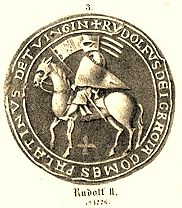
Rudolph II, Count Palatine of Tübingen was Count Palatine of Tübingen and Vogt of Sindelfingen. He was the younger son of Rudolph I and his wife Matilda of Gleiberg, heiress of Giessen.
